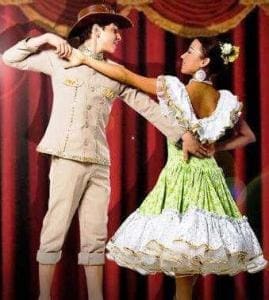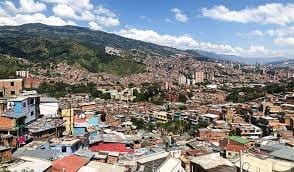
Colombia which is officially referred to as Republic of Colombia, which is located in northwestern South America. Colombia has Caribbean Sea coast in the north which is around 1,600 km and Pacific Ocean on the west boundary. The country is bordered by Panama, which divides the two water bodies – the pacific ocean and the Caribbean Sea in the west. Columbia shares its border with Venezuela in north, Brazil on the east, and Peru and Ecuador on the south. Bogotá is the national capital which is situated on a high plateau in the northern Andes Mountains. The population mainly resides in the mountainous interior.
Colombia is the only American nation that is named after Christopher Columbus, the “discoverer” of the New World. Colombia strongly reflects its history as a colony of Spain. In Colombia the official language is Castilian Spanish. In addition to Spanish there are more than 180 indigenous languages and dialects belonging to major linguistic groups as Arawakan, Chibchan, Cariban, Tupi-Guaraní, and Yurumanguí. About three-fifths of the population is mestizo. Most Colombians are followers of Roman Catholicism. Religions in Colombia are Christianity, Roman and Protestant.

Due to the world’s longest mountain range – the Andes, a number of different climates in Colombia can be seen, from having tropical climate with variations within six natural regions and depending on the altitude, temperature, humidity, winds and rainfall. Earlier the economy of Colombia was entirely based on gold mining, including the robbing of the metal from Indian graves (guacas) in the colonial period. The modern economy is much more based, with the exploitation of hydrocarbon fuels and several metals, agricultural production, and the manufacture of goods for export and home consumption. Colombia was one of the few Latin American countries not to suffer a debt crisis in the 1980s.
Agriculture remains a major component of the Colombian economy. Industrial development has been remarkable since the 1940s. A substantial proportion of Colombian land is uncultivated because of the prevalence of poor soils and unfavourable climatic conditions. The textile industry employs the largest share of workers and contributes a substantial part of the national income. In addition to supplying the national market, the larger firms also export fabric and yarn
Textiles of Colombia:
The Andes mountain range have significant impact on the textiles and clothing of Colombia due to different climate. The textiles and clothing of the Colombians are made using natural fibers and are with bright colours. The Colombian women are aware of the importance of rural traditions to their culture and work hard for long hours to make sure the tradition stay alive. People belonging to El Recreo located in rural Colombia works on a project that helps to keep the ancient process of hand-dyed wool being spun into garments and accessories, alive. Outside the weavers house a dark brown sheep is tied to the ground along with a big pair of sewing scissors patiently sheered the animal for its wool. The harvest of the new wool is collected and stored for the next 48 hours before further processing – the reason being an ancient belief that the sheep would die of cold if they did not store the fresh wool for that amount of time. The weavers spun yarn from an earlier harvest of wool and then demonstrated how they worked the weaving loom.
When we talk about history, there are many different stories we get to hear about a same thing. Similarly, even the Wayuu community of Colombia has its own story for weaving of textiles. It is said by the women of the Wayuu community, that the tradition of weaving comes from Waleker, a spider that taught the Wayuu women how to weave. This art is also linked to menstrual cycle of the women, the initiation of adolescent girls to womanhood. When a girl undergoes her menstrual cycle the girls stay away from their family and are taught with the traditions, customs, culture and household tasks of Wayuu by their elders and Art of weaving is considered as one of the most important tasks for a Wayuu woman. The intricate, hand-stitched, geometric motifs characterize the ancient Wayúu weaving and represent the elements found in the matriarchal structure of their society. The technique and the designs have been passed down from generation to generation.

At the end of their seclusion, the girls are formally introduced into society as majayut – young ladies, ready to face the adult life in their communities which are distributed around the important urban centers of the district of La Guajira, such as Riohacha, Uribia, Canyons, Nazareth, Maicao, Manaure and Bahia Portete.

Wayuu bag
The Wayuu fabric is hand-stitched colorful kanás (weaving designs), represent the elements of the society and daily life of the indigenous people, as well as elements of their natural environment. The elements include universe, flowers, animals. More the complex and elaborate motifs, the more valuable the handcrafted piece is. The Wayuu women weave chinchorros which are the traditional Wayuu hammocks, backpacks, mats, and sandals. Chinchorro hammock is soft, elastic, with sparse weave but have a strong yarn quality, whereas the modern hammocks are heavy and compact. However, the most common woven creations are the mochilas, or susu, small bags, made of colourful yarn with intricate patterns and motifs. They are the most sold product on the national and international market.

Maguey cactus
Fiber from maguey cactus is used to crochet the traditional mochilas – bags. Each bag is crocheted by one Wayuu woman and it takes around twenty-thirty days to complete depending on the crochet pattern.

Wayuu dress
The Wayuushe’ or Wayuu Blanket is the handcrafted traditional dress of the Wayuu women that can be made with cotton, silk or terlenka. The typical Wayuushe’ is square or rectangular; its neck may be a square ‘V’ or an oval. In the front, there is a string that anchors the blanket or ‘manta’ at the waist; the string is knotted at the back of the dress.
Clothing and Costumes of Colombia:
Every region of Colombia is having different climate and culture and so are the dressing of the people. It varies right from amount of fabric used to the different accessories and adornments used. The traditional Huila dress is worn during the Sanjuanero dance. Women wear a ruffled white blouse that hangs off the shoulders, adorned with lace and sequin. A wide skirt opened during dance is made from colorful satin and lace, often with colorful floral decorations along with colorful flowers in her hair. The men’s dress is with simple white shirt and trousers, a red scarf, leather belt and a hand-made hat.

Sanjuanero dance
In Boyacá and Cundinamarca, men and women wear a wool poncho known as the ruana. Men often wear twill pants, cotton shirts and brimmed hats whereas women wear long cotton skirts with embroidered cotton blouses, shawls, brimmed hats and white sandals. In the Eastern Colombia, where the climate is warm and horseback riding along with cattle ranching are a way of life, the clothing there is light and simple.
For the traditional Joropo dance, women wear a wide skirt that falls upto the knee, featuring a number of different fabrics, with a red or white background and flowers. A three-quarter sleeve blouse is decorated with ribbons matching the skirt, and ribbons or flowers to decorate the hair. The men traditionally wear white pants rolled up the leg, for crossing the river, and a black or red shirt and a wide-brimmed hat, made of heavy material so it does not fly off when riding.

Joropo dance
While moving next towards the Caribbean coastal region, the clothing there is light and airy clothing to combat the heat and humidity.
Traditionally men combine bright colored shirts and linen pants, or in other parts of the region with white pants and a white shirt, with a typical woven bag, draped over one shoulder. Women wear light and flowy skirts and tops. And there are few items more Colombian than the “vueltiao” hat, or sombrero vueltiao, which comes from this region. The black and white brimmed hats are woven from dried cane leaves and worn across the Coast. In 2004, the hat was declared a Cultural Symbol of the Nation. The Wayuu women wear a loose dress and sandals with woolen tassels, according to social rank. They weave the traditional and colorful Wayuu bags.

Vueltiao hat
The sparsely populated Amazon region to the south have a number of native groups, indigenous tribes which have their own ways of life and dress. Many groups exist semi-nude form. Women may wear a calf-length skirt and white blouse with belts and necklaces. As men often fish here, they may wear white pants or skirt, with the native necklaces and accessories.

Indigenous tribe – amazon
While on the Pacific Coast, traditionally women wear colorful, pastel clothing, made out of soft fabrics and sewn with flowers, ribbons, ankle length colorful skirts. Men, also wear loose and colorful clothes with shoes or sandals made out of natural materials and plant fibers. African influence like use of headwraps and other accessories can be seen in Pacific communities.
This multi-faceted Colombia is a great attraction due to the huge diversity right from geographical region to the traditional culture. The textiles as well as the costumes are the most attractive one.
Article Written by-
Rutu Kanade
Intern at TVC
MSc. Textile and Fashion Technology
College of Home Science Nirmala Niketan
Reference:
https://procolombia.co/en/content/textiles-and-apparel-sector
https://en.wikipedia.org/wiki/Colombia
https://www.britannica.com/place/Colombia/Transportation
www.google.com – for photographs

